Table of Contents
Nuts are a food appreciated by almost every health enthusiast. They are not only very tasty but also contain a concentrated amount of beneficial nutrients. They effortlessly supplement your diet with healthy fats, vitamins, and provide various health benefits. Which nuts are worth including in your diet?
In the article, you will read about the benefits of these nuts:
What Are Nuts, and What Makes Them Exceptional?
Nuts are also known as “fruit in the shell.” They are fruits of trees, and their seeds are hidden in a hard shell. These seeds are what we call nuts. As you probably know, they come in various shapes, colours, and boast a wide range of interesting flavours. Chefs, bakers, and connoisseurs of quality gastronomy all value them.
Apart from their delightful taste, they stand out for their rich content of essential nutrients. They are an indispensable part of healthy diets, offering a multitude of health benefits. Nuts are rich in healthy fats, fibre, and some also excel in protein content. Moreover, they serve as a concentrated source of vitamins, minerals, and other beneficial biologically active substances.
Truly, nuts are a food that can elevate your diet to a higher level. It’s great that there are several types of nuts to choose from. You can enjoy them in their natural form, but you can also diversify our diet with salted, roasted, or blanched variations. Those with a sweet tooth will appreciate nuts covered in chocolate. Nut butters made solely from blended nuts also offer interesting options in the kitchen. Some nuts are even processed into nut flour, serving as an alternative to traditional wheat flour.
If you want to learn more about nut butters, don’t miss the article on Nut Butters and Their Differences, Nutritional Values, and Benefits.
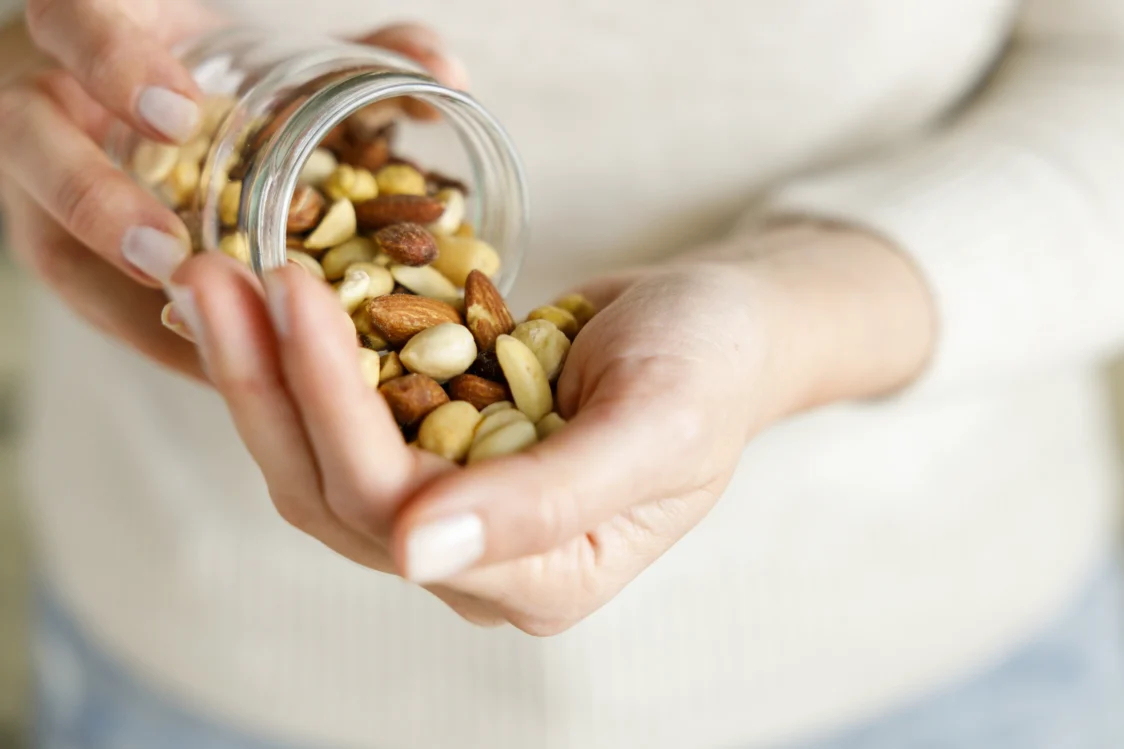
What Are the Most Nutritious and Best Nuts?
1. Walnuts
Walnuts have a rich history. They grow on a tree called the Persian walnut, likely originating in the Persian Empire, present-day Iran. These popular nuts, resembling the human brain, remain among the favourites and most widely used. Not only do they look like the brain, but they are also beneficial for it, thanks to their rich content of omega-3 fatty acids. [10]
What health benefits do walnuts have?
- Research suggests that daily consumption can help improve the cardiovascular system. One study recommends an effective portion of 20 – 75 g of walnuts daily.
- They have a positive impact on lipid profiles, specifically on normal cholesterol and triglyceride levels.
- They can alleviate endothelial dysfunction, the initial stage of atherosclerosis, a condition where fats and various blood components accumulate in the vessel wall, leading to thickening and narrowing of the vessels and gradually causing issues such as myocardial infarction.
- Walnuts are also beneficial for brain and nervous system health.
- They help control hunger by increasing the feeling of satiety. Therefore, they should not be forgotten during diets, where they can assist in weight loss.
- Studies also point to their anti-inflammatory effects. [18]
You might be interested in these products:
What actually is in walnuts?
Walnuts are primarily valued for their content of healthy fats. They have a significant proportion of alpha-linolenic acid (ALA), an omega-3 fatty acid crucial for the brain and heart. This fatty acid is generally lacking in our diets because it is not abundantly present in most foods, including most nuts. However, walnuts contain approximately 9 g / 100 g, which is the highest amount of omega-3 ALA among all types of nuts.
According to the European Food Safety Authority (EFSA), ALA should constitute approximately 0.5% of the total daily energy intake. For a daily intake of 2000 kcal, this corresponds to roughly 1 g of ALA per day. To achieve this amount, consuming about 11 g of walnuts per day (less than a small handful) is sufficient.
Walnuts are also rich in antioxidants, helping to protect the body from the effects of free radicals that contribute to various diseases, including cancer or cardiovascular diseases. Among these effective substances are vitamin E, as well as polyphenols and flavonoids.
Average Nutrient Content in Walnuts
| Energy Value | 686 kcal |
| Fat | 65 g |
| – Monounsaturated Fatty Acids | 9 g |
| – Polyunsaturated Fatty Acids | 47 g |
| Carbohydrates | 7 g |
| Fibre | 6.7 g |
| Protein | 15 g |

2. Almonds
Almonds are the seeds of the almond tree, a fruit tree with pink flowers and yellow fruits. It is grown around the Mediterranean Sea and in similarly warm regions, with California currently being the largest producer of almonds.
What health benefits do almonds have?
- Studies show their impact on reducing total and LDL (bad) cholesterol levels. [3]
- They can slow down carbohydrate absorption, helping to mitigate the rise in blood sugar levels (glycemia). [3]
- Positive effects are also observed in people with type 2 diabetes.
- Almonds have antioxidant effects, protecting the body from free radicals generated by oxidative stress. [13]
- They are beneficial for the brain and cognitive functions, including memory.
What actually is in almonds?
Almonds are rich in healthy fats, with monounsaturated fatty acids (MUFA), specifically oleic acid, comprising the largest proportion. Oleic acid is known for its positive effects on blood cholesterol levels. They also excel in their fibre content, which is the highest among all types of nuts, benefiting digestion and the intestinal microbiome. [7,30]
Almonds are rich in micronutrients, including vitamin E, known for its antioxidant properties. They also have a significant content of folic acid, crucial for the development of the nervous system, especially important for pregnant women.
They are also abundant in magnesium and potassium. They also have a significant proportion of calcium and iron, however, it’s essential to note that these mineral substances are absorbed to a lesser extent from plant sources than from animal sources. Vegans and those with a predominantly plant-based diet should pay the most attention to this.[3,30]
If you would like to read more about almonds, don’t forget to check out our comprehensive article Almonds? What effect do they have on the heart, skin or brain and how much to eat a day?
Average Nutrient Content in Almonds
| Energy Value | 597 kcal |
| Fat | 50 g |
| – Monounsaturated Fatty Acids | 31.6 g |
| – Polyunsaturated Fatty Acids | 12.3 g |
| Carbohydrates | 9.5 g |
| Fibre | 12.5 g |
| Protein | 21 g |

3. Hazelnuts
Hazelnuts originate from Turkey. They have been cultivated for several thousand years, with Turkey remaining their largest producer to this day. Interestingly, they are not only tasty and nutritious but can also be beneficial for the environment. The tree on which they grow is ecologically friendly, as it is resistant to drought and does not require a lot of water for survival. [8,24]
What health benefits do hazelnuts have?
- Hazelnuts are praised for their positive impact on the lipid profile, helping to reduce LDL cholesterol levels.
- They contribute to improving the condition of blood vessel walls, thereby benefiting the overall cardiovascular system.
- Studies indicate their role in reducing inflammatory markers such as C-reactive protein.
- They are known for their antioxidant effects.
- Hazelnuts can also help lower blood sugar levels (glycemia) due to their relatively high fibre content, which slows down sugar absorption from the blood. [16]
Discover our bestsellers:
What actually is in hazelnuts?
Hazelnuts have a high content of monounsaturated fatty acids and are also rich in omega-6 polyunsaturated fatty acids. They contain significant amounts of vitamin E, copper, potassium, and manganese, essential for bone and cartilage health. The antioxidants, including vitamin E, polyphenols, and flavonoids, are mostly concentrated in the hazelnut shell, making it beneficial to consume hazelnuts as they are. [16,17]
Average Nutrient Content in Hazelnuts
| Energy Value | 656 kcal |
| Fat | 61 g |
| – Monounsaturated Fatty Acids | 45.7 g |
| – Polyunsaturated Fatty Acids | 8 g |
| Carbohydrates | 7 g |
| Fibre | 9.7 g |
| Protein | 15 g |
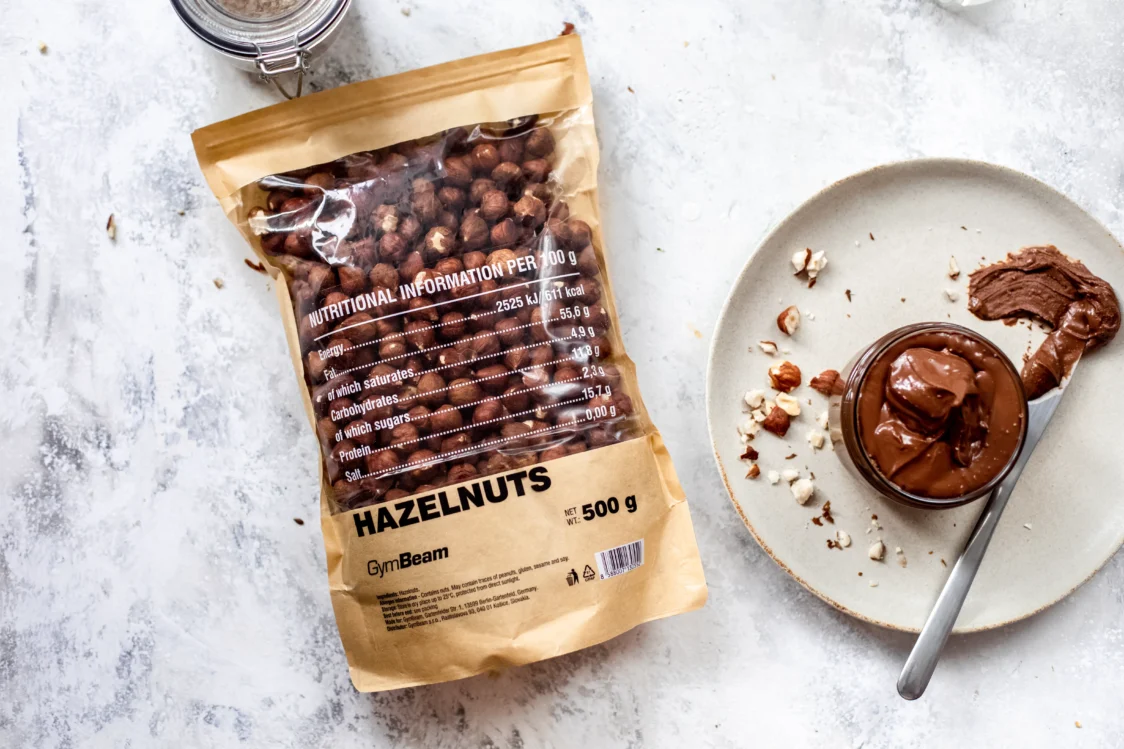
4. Cashews
Cashew nuts grow on a tropical tree native to Brazil. This tree can reach a height of up to 10 meters and is characterized by its interesting yellow fruits known as cashew apples. These fruits are edible and used in the production of jams or juices. The cashew nut grows at the end of these apples, hidden in a hard green shell. [15]
Unlike other types of nuts, cashews need to be cooked before reaching store shelves, as raw nuts contain the toxic substance urushiol and are not suitable for consumption in this state.
What health benefits do cashews have?
- Studies describe their ability to fight free radicals, thanks to a variety of antioxidants.
- They help protect heart and vascular health.
- Cashews may be beneficial for bones due to their calcium and magnesium content.
- They contribute to maintaining good eyesight. [14]
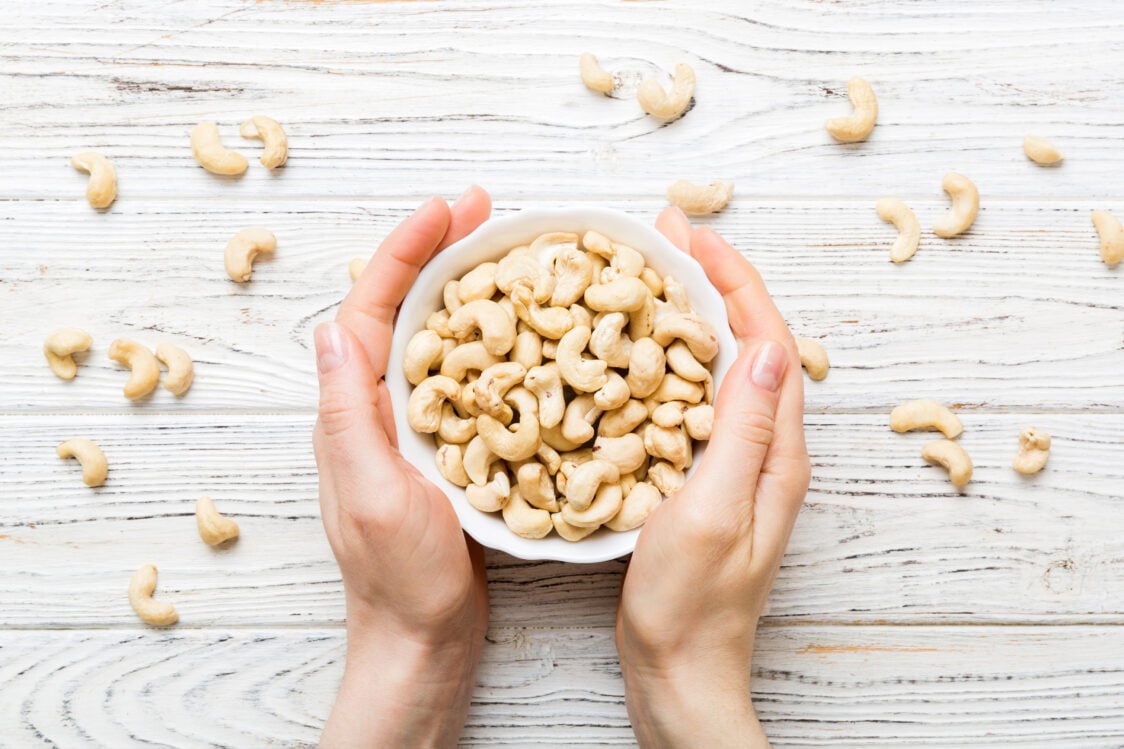
What actually is in cashews?
Cashews have a relatively high protein content compared to other nuts. Like most plant sources, they do not have an optimal spectrum of essential amino acids, so they should be considered only as a supplement to daily protein intake. Like other types of nuts, they are valued for their content of healthy fats, especially monounsaturated fatty acids.
What’s also worth mentioning in regards to cashews is its significant amount of thiamine (vitamin B1), phosphorus and zinc. In addition to zinc, their antioxidant properties are attributed to antioxidants such as zeaxanthin, lutein, and beta-carotene. The latter also serves as a precursor to vitamin A, which is essential for functional vision and immunity. Additionally, they contain substances like phytosterols, which are beneficial in combating high cholesterol levels in the blood. The reason for this is that they resemble cholesterol and can be absorbed in the intestine in its place. [15,30]
Average Nutrient Content in Cashews
| Energy Value | 581 kcal |
| Fat | 44 g |
| – Monounsaturated Fatty Acids | 24 g |
| – Polyunsaturated Fatty Acids | 7.8 g |
| Carbohydrates | 26.7 g |
| Fibre | 3.3 g |
| Protein | 18 g |

5. Brazil Nuts
Brazil nuts, also known as Para nuts, are native to the rainforests of Brazil, Bolivia, and Peru. The tree on which they grow is considered one of the largest and longest-living species in the Amazon rainforest.
What health benefits do Brazil nuts have?
- Studies primarily highlight their antioxidant properties, mainly due to selenium, a crucial component of the glutathione antioxidant system. They aid in protection against various health issues, including metabolic and tumor-related diseases.
- They may help reduce oxidative stress indicators.
- They have also shown to have anti-inflammatory effects.
- Research indicates their positive impact on blood cholesterol levels.
- They can contribute to maintaining thyroid health due to their selenium content, essential for thyroid hormone function. [9,22]
What actually is in Brazil nuts?
Brazil nuts are a good source of healthy fats, with a similar proportion of polyunsaturated and monounsaturated fatty acids. They are exceptionally rich in selenium, containing as much as 1920 µg per 100 g, making them a valuable source of this hard-to-find mineral.
The recommended daily dose of selenium according to EFSA is 70 µg. It is enough to consume 3 g of Brazil nuts (1-2 nuts) per day in order to achieve this desired daily intake. [26,30]
In addition, they are rich in vitamin E, folic acid, magnesium, potassium and calcium. [9]
Average Nutrient Content in Brazil Nuts
| Energy Value | 691 kcal |
| Fat | 67 g |
| – Monounsaturated Fatty Acids | 24 g |
| – Polyunsaturated Fatty Acids | 24.4 g |
| Carbohydrates | 4.2 g |
| Fibre | 7.5 g |
| Protein | 14 g |
6. Pistachios
Pistachios grow on a tree originating from Asia, capable of living up to 300 years. Today, they are well-known and cultivated in the Mediterranean region, thriving in dry sandy soils due to their long roots, which can draw water from several meters deep.
Most pistachios you can buy are in their shell, but if you lack patience, you can reach for the shelled ones as well.
What health benefits do pistachios have?
- Studies suggest that pistachios help maintain optimal blood sugar levels both after meals and throughout the day, making them suitable for diabetics and people with prediabetes.
- They are beneficial for cardiovascular health.
- Some research indicates a connection with a lower incidence of cancer.
- Pistachios can also be beneficial for digestion and the composition of the intestinal microbiome.
What actually is in pistachios?
Pistachios, in addition to healthful fats, have a relatively high protein content compared to other types of nuts. They boast an interesting spectrum of essential amino acids and have a high fibre content, making them a versatile and exceptionally nutritious nut. They are rich in micronutrients, including potassium, magnesium, vitamin E, and vitamin B6 (pyridoxine).[6,20]
Pistachios contain phytosterols, lutein, polyphenols, and are a good source of arginin, which serves as a precursor to nitric oxide (NO), helping to widen blood vessels and maintain healthy blood pressure.
Average Nutrient Content in Pistachios
| Energy Value | 575 kcal |
| Fat | 45.3 g |
| – Monounsaturated Fatty Acids | 23.3 g |
| – Polyunsaturated Fatty Acids | 14.4 g |
| Carbohydrates | 16.4 g |
| Fibre | 10.6 g |
| Protein | 20 g |
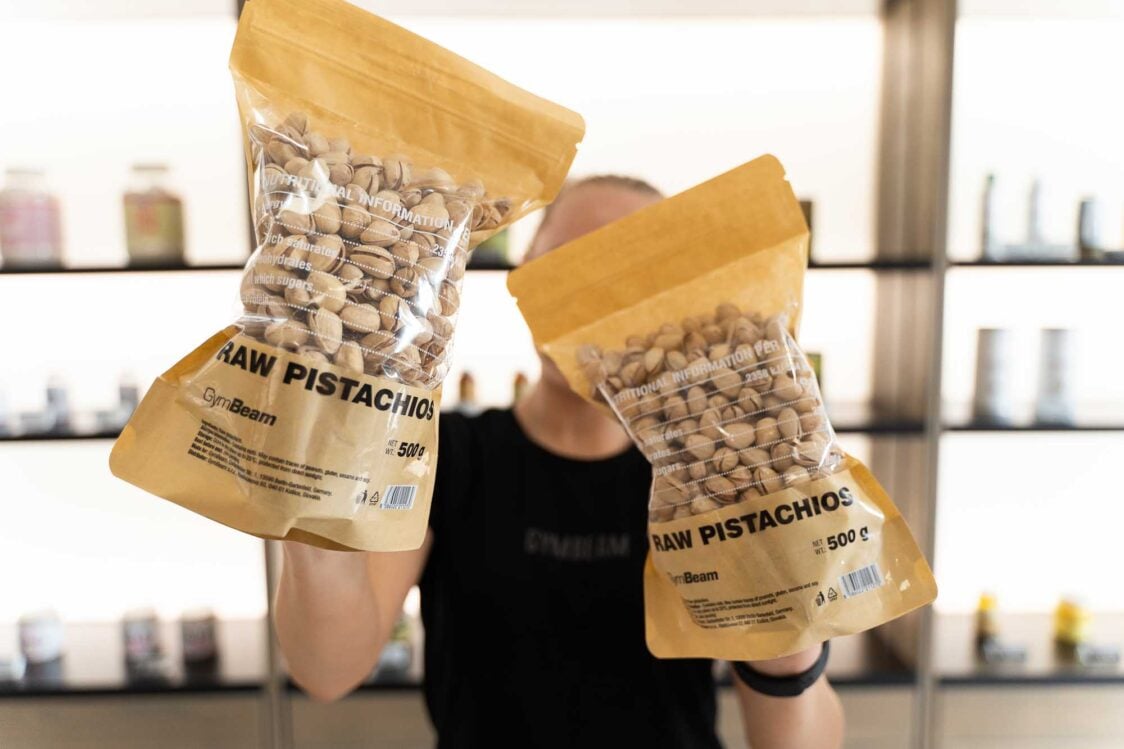
7. Macadamia Nuts
Macadamia nuts have been a regular part of the diet of Australia’s indigenous people. However, they are also known as Hawaiian nuts, as they were first commercially produced in Hawaii.
What health benefits do macadamia nuts have?
- Macadamia nuts may contribute to achieving normal cholesterol levels, promoting good cardiovascular health. [12]
- Their consumption is associated with a lower risk of metabolic syndrome, a condition characterized by type 2 diabetes, high fasting glucose, hypertension, low HDL (good) cholesterol, elevated triglycerides, and obesity.
- Rich in fibre, macadamia nuts act as prebiotics, supporting beneficial gut bacteria and positively influencing the composition of the intestinal microbiome.
What actually is in macadamia nuts?
These nuts are characterized by their high-fat content, significantly surpassing that of other types. Nearly 80% of this fat consists of beneficial monounsaturated fatty acids. While they are calorically dense, the included fat content contributes to sustaining a longer feeling of satiety. This effect may be enhanced by the relatively high fibre content, promoting a sense of fullness. [18]
Macadamia nuts are also rich in vitamin E, vitamin B1 (thiamine), copper, magnesium, and have an unusually high manganese content. [5]
They also contain various bioactive compounds, and one noteworthy group is phytosterols. These compounds, in conjunction with monounsaturated fatty acids, play a role in positively influencing cholesterol levels in the blood.
Average Nutrient Content in Macadamia Nuts
| Energy Value | 752 kcal |
| Fat | 75.8 g |
| – Monounsaturated Fatty Acids | 59 g |
| – Polyunsaturated Fatty Acids | 1.5 g |
| Carbohydrates | 5.2 g |
| Fibre | 8.6 g |
| Protein | 7.9 g |

8. Pecans
Pecan nuts grow on massive trees reaching heights of up to 50 meters and can live up to 200 years. They originate from North America and Mexico, and their name comes from the word “pecan,” meaning “nut that requires a stone to crack” in Algonquian language. They are not as popular as some other types of nuts, but you may have encountered them in the form of a popular pecan braid or pie. [23]
What health benefits do pecans have?
- Studies suggest positive effects on the brain and cognitive functions.
- They can also help improve the lipid profile.
- Scientists describe their antioxidant and anti-inflammatory effects. [23]
What actually is in pecans?
Similar to the previous nuts, pecans are also rich in monounsaturated fatty acids. However, they also contain a significant amount of polyunsaturated fatty acids, particularly omega-6 linoleic acid. Additionally, they are abundant in manganese, magnesium, potassium, and calcium. Pecans also stand out for their copper content, which is essential for functions such as a healthy immune system, as well as for maintaining healthy hair and skin. In just 30 grams of nuts (one handful), is up to one-third of the recommended daily copper intake. [26,27,30]
Average Nutrient Content in Pecans
| Energy Value | 722 kcal |
| Fat | 72 g |
| – Monounsaturated Fatty Acids | 41 g |
| – Polyunsaturated Fatty Acids | 21.6 g |
| Carbohydrates | 4.4 g |
| Fibre | 9.6 g |
| Protein | 9.2 g |
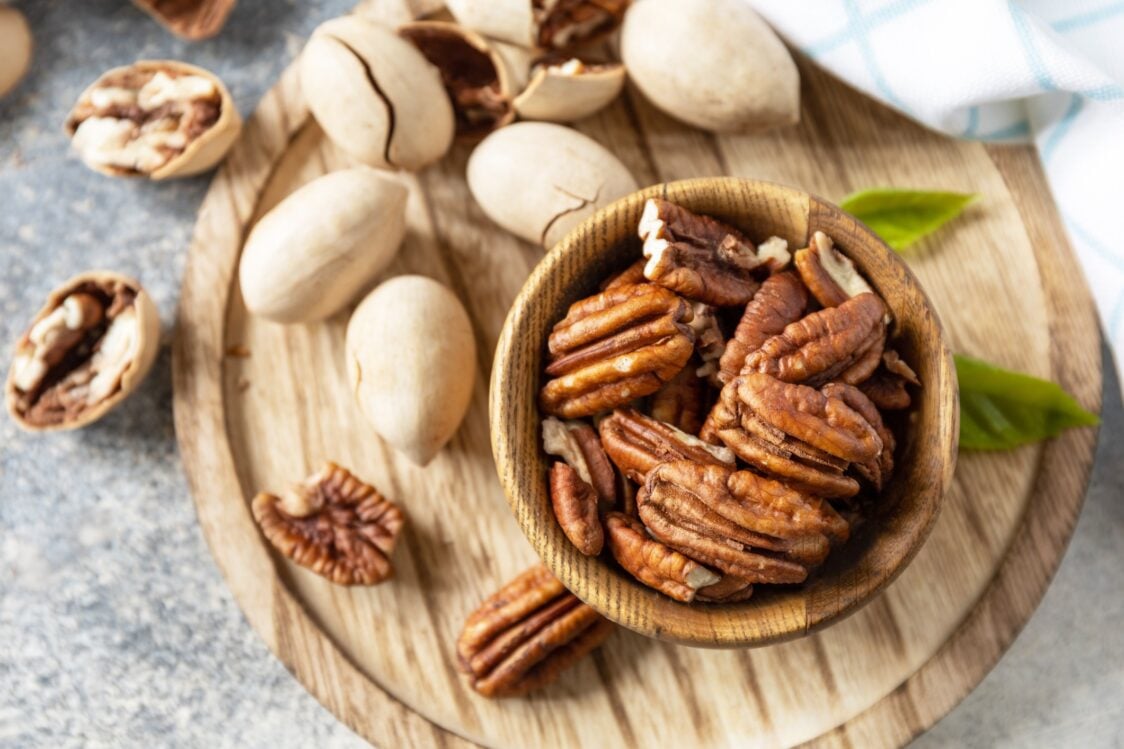
9. Pine Nuts
Pine nuts are, in fact, the seeds of pine trees and are mainly cultivated in Asia, Europe, and North America. They are notably more expensive than other nuts due to the lengthy and complex harvesting process, with pine trees taking approximately 25 years to produce edible pine nuts.
What health benefits do pine nuts have?
- Studies suggest they help maintain healthy cholesterol and blood pressure levels, contributing to overall cardiovascular health.
- Scientists highlight their anti-inflammatory and anti-rheumatic properties.
- Pine nuts, particularly due to the presence of pinolenic acid, may help reduce appetite, making them potentially useful for weight management.
What actually is in pine nuts?
Pine nuts have an unusually high fat content, primarily composed of health-beneficial unsaturated fatty acids, especially linoleic acid. Some varieties also contain pinolenic acid (PNLA), which researchers attribute to its potential appetite-suppressing effect.
This type of nut is also rich in iron, magnesium, phosphorus and zinc. As for vitamins, it contains a significant proportion of folic acid and vitamin B3 (niacin), which is necessary, for example, for a functional nervous system and psyche. [27]
Average Nutrient Content in Pine Nuts
| Energy Value | 716 kcal |
| Fat | 68.4 g |
| – Monounsaturated Fatty Acids | 18.8 g |
| – Polyunsaturated Fatty Acids | 34 g |
| Carbohydrates | 9.7 g |
| Fibre | 3.7 g |
| Protein | 13.7 g |
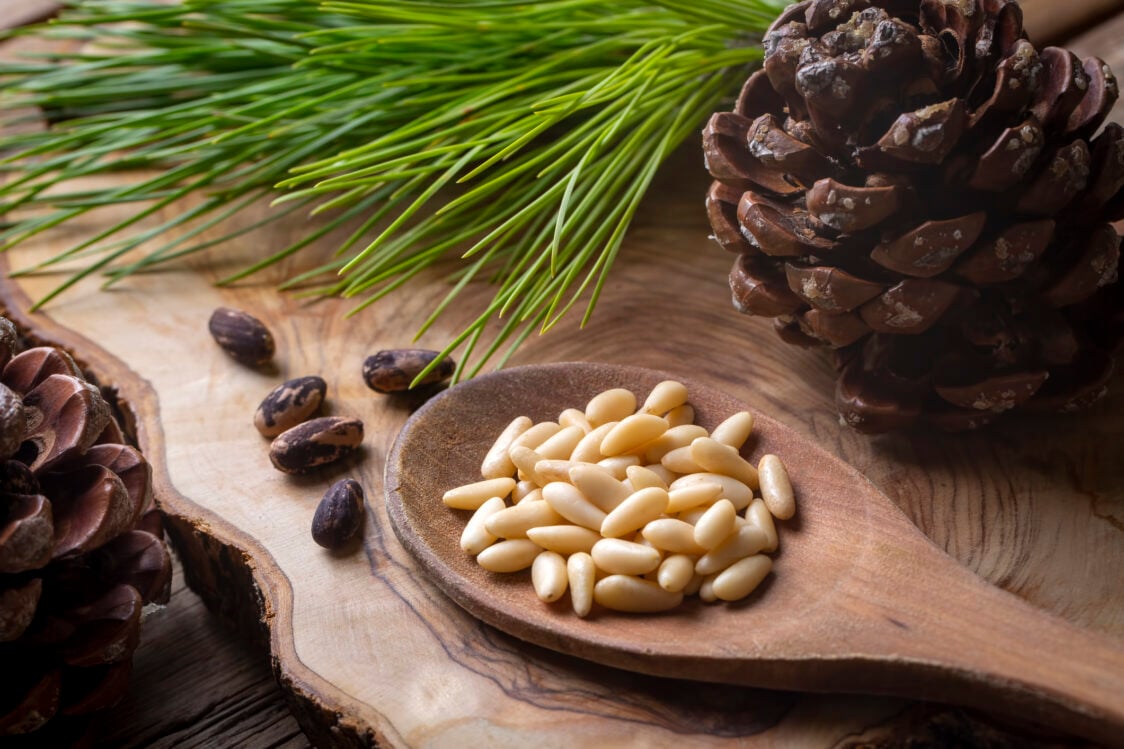
10. Peanuts
Even though peanuts are commonly referred to as nuts, they are, in fact, legumes. They are the seeds of the oilseed plant called peanut, originating from South America. Cultivated in over 100 countries worldwide, peanuts are a culinary staple in many global cuisines, including Asian dishes. Additionally, peanut butter is one of the most popular and beloved spreads out there.
What health benefits do peanuts have?
- Studies indicate a connection between peanut consumption and a lower risk of cardiovascular diseases.
- Peanuts are associated with a lower risk of colorectal cancer.
- Scientists also talk about a lower risk of prostate cancer, possibly thanks to the phytosterols contained.
- Components such as unsaturated fatty acids, arginine, and magnesium contribute to potential anti-inflammatory effects.
- Peanuts might play a small role in protection against Alzheimer’s disease and the formation of gallstones.
- Peanuts can contribute to inducing a feeling of satiety. [2]
What actually is in peanuts?
Although peanuts are legumes, their composition is similar to nuts. They are rich in fats, with a predominant presence of monounsaturated fatty acids such as oleic and linoleic acids. But they do share something with legumes; high protein content. One serving of peanuts (30g) contains up to 8g of protein, and their essential amino acid spectrum is comparable to soy, making them a relatively high-quality protein source. [2,21]
Peanuts are also rich in calcium, magnesium, potassium, vitamin B3, folic acid, and other B vitamins. Among other bioactive substances, they boast the presence of resveratrol, an antioxidant known for its effectiveness, primarily found in red wine. [2]
Average Nutrient Content in Peanuts
| Energy Value | 591 kcal |
| Fat | 49 g |
| – Monounsaturated Fatty Acids | 24.4 g |
| – Polyunsaturated Fatty Acids | 15.6 g |
| Carbohydrates | 7.5 g |
| Fibre | 8.5 g |
| Protein | 25.8 g |
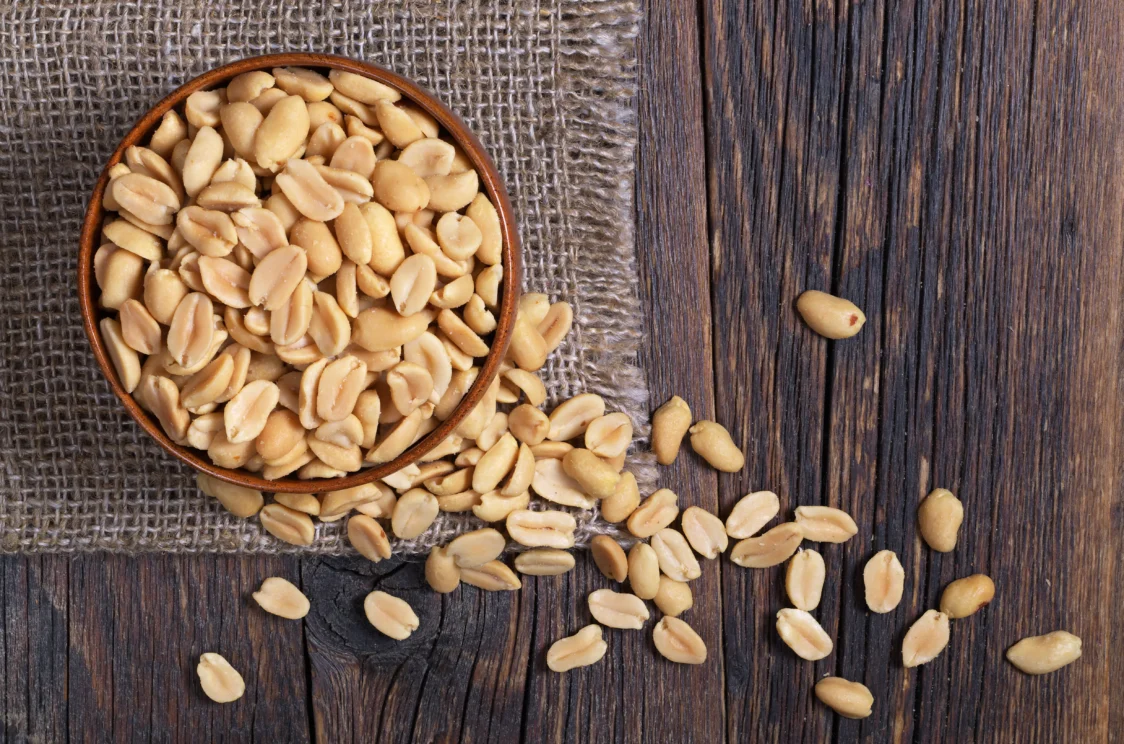
How Many Nuts to Eat Daily?
The appropriate portion of nuts for you personally depends on the current composition of your diet. If your diet lacks nutrition, especially healthy fats, you might benefit from a larger portion compared to someone who regularly consumes plant oils or seeds. The amount also depends on the overall caloric content of your diet.
For those with a balanced and high-quality diet, a general recommendation is to consume approximately 30 grams of nuts daily, which corresponds to roughly a handful.
Are Nuts Suitable for Weight Loss?
Considering how calorie-dense nuts are, one might assume that their regular consumption could lead to weight gain, right? Well, it’s the other way round. Nuts are actually suitable for a weight loss diet. Studies even say that their regular intake is associated with successful weight reduction. The high-fat content helps induce and maintain a feeling of fullness, ultimately aiding in the intake of fewer calories throughout the day.
However, if you are trying to lose weight, remember that it’s essential to maintain a calorie deficit. Therefore, it wouldn’t be the best idea to eat a pack of nuts in the evening while watching the TV. Instead, try consuming them in reasonable and controlled portions as part of a diverse and balanced diet.
Are Nuts Suitable for a Keto Diet?
Keto diet, also known as low-carb diet, aims to limit the intake of carbohydrates. However, these need to be replaced with something to achieve sufficient overall energy intake. Fat, which is abundantly present in nuts, plays a crucial role along with proteins in this regard. More suitable types of nuts for a keto or low-carb diet are those with a low carbohydrate content and high fat content. Among all the mentioned types, Brazil nuts have the least carbohydrates, while macadamia nuts have the highest fat content and relatively low carbohydrate content. However, if you can fit the portion of nuts into your targeted daily carbohydrate intake, any type is fine.
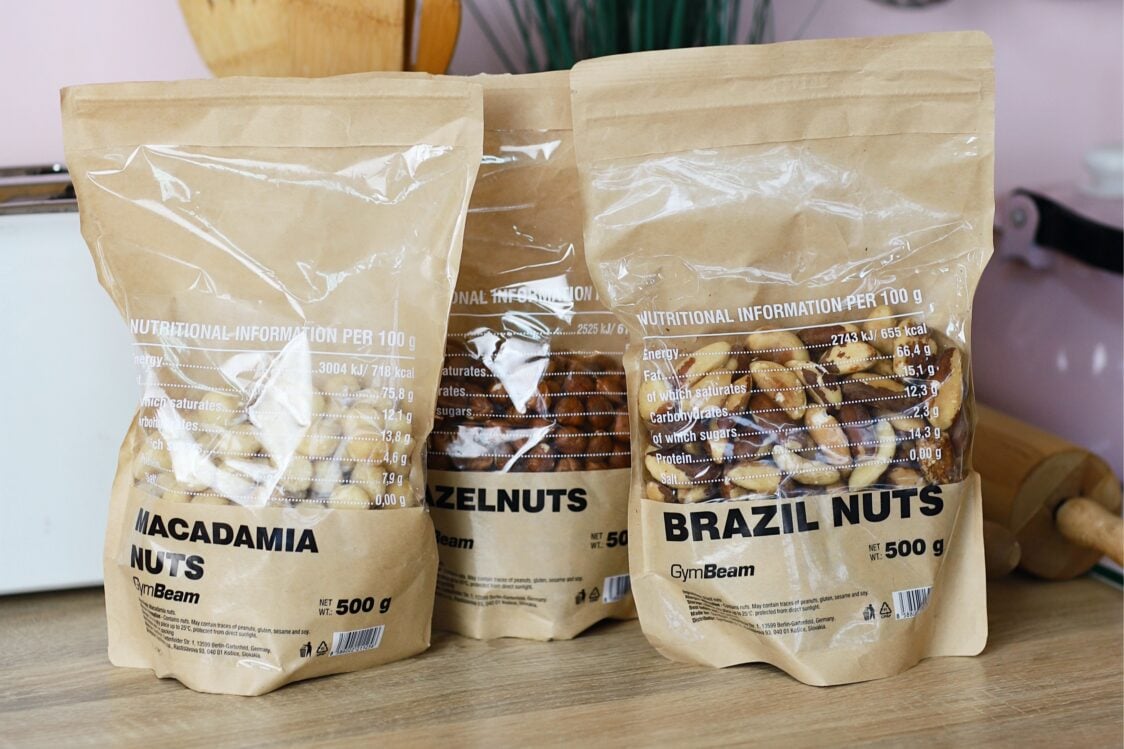
What Recipes You Can Incorporate Nuts Into?
If you decide to include nuts in your diet, you will probably never run out of inspiration and ideas. There are countless ways to enrich food with nuts. In addition, you can alternate the individual types, which always gives you a new taste experience. You can also supplement your favourite dishes with nut butters. Pistachio, almond, hazelnut, cashew or peanut butter will certainly not disappoint you.
- Add nuts to your cereal or oatmeal.
- Combine them with fruits in yoghurt or quark, or add them to your smoothie.
- Use them to make granola or homemade cereal bars.
- Incorporate them into pies, Bundt cakes muffins, banana bread, or other sweet treats.
- Prepare nut-based creams for cakes and other desserts.
- Include them in salads, pasta sauce, or meat dishes.
- Create delicious pesto sauces.
- Grind nuts with some water, strain them, and prepare a drink known as nut milk. You can use almonds, walnuts or cashews to make an alternative to regular cow’s milk.

How to Store Nuts?
Most people store nuts in the kitchen cupboard. But did you know that there are better ways to do that? Nuts are quite susceptible to spoilage. The high content of unsaturated fatty acids, which makes them such healthy foods, also predisposes them to spoil quite fast. These unsaturated fats can quickly oxidize and change their properties. In addition, they are susceptible to contamination by microorganisms, most often fungi.
Nuts are subject to oxidation due to exposure to air and light. Therefore, it is important to store them in a dark and dry place. If you also store your nuts in the cupboard, make sure they are well sealed and dry.
However, the ideal storage solution for nuts is the refrigerator. Nuts can keep their quality there for up to one year. Just put them in a resealable glass container.
If you want to know more about how to properly store different foods, read our article How to properly store food so that it lasts as long as possible.

When to Avoid Nuts?
Nuts are generally a very healthy and nutritious food. However, in some cases, for example with specific diseases, they can also be harmful. When should you avoid nuts?
- Nut Allergy: Nuts and peanuts are among the strongest food allergens. Allergy symptoms can manifest as itching of the skin, swelling of the mouth, digestive issues, coughing, sneezing, and even a severe anaphylactic reaction. Therefore, in the case of an allergy to a specific type of nut, it is important to exclude it from the diet. If you are unsure whether a particular food contains nuts, allergen labeling on the packaging can help you. In the European Union, nuts (listed as allergen number 8), peanuts (number 5), and other allergens must be indicated on the packaging if the food contains them. In the UK, a similar legislation known as ‘Natasha’s Law’ came into force in October 2021. [28]
- Histamine Intolerance: This is a diagnosis where the body cannot effectively eliminate the biogenic amine histamine. This can manifest, for example, as headaches, vomiting, low blood pressure, and many other diverse symptoms. Part of the treatment involves avoiding foods that contain histamine and foods that the person has observed to cause problems. Some nuts, such as walnuts and peanuts, are also among these foods. [4,29]
- Spoiled and Musty Nuts: Since nuts are susceptible to spoilage, it is very easy for them to become mouldy. Therefore, store them properly and check their appearance and aroma.
Are Nuts Suitable During Pregnancy?
Contrary to outdated advice, pregnant women can enjoy all nuts, including peanuts, without fearing an increased risk of allergies in their children. Including nuts in the diet during pregnancy is actually encouraged, as they provide essential nutrients beneficial for the developing baby. [1,25]
What should you remember?
If you are looking for a food that could magically enrich your diet with nutrients, nuts are the right choice. They are full of fibre, healthy fats, minerals, vitamins, and other beneficial bioactive substances. To enjoy their diverse health benefits, simply indulge in a handful of almonds, cashews, walnuts, pecans, or other varieties every day. So, which ones will you choose today?
Did today’s article capture your interest? If it taught you something new, we would be delighted if you shared it with your family and friends.
[1] ABRAMS, E.M. - SICHERER, S.H. Maternal peanut consumption and risk of peanut allergy in childhood. – https://www.ncbi.nlm.nih.gov/pmc/articles/PMC6041250/
[2] ARYA, S.S. et al. Peanuts as functional food: a review. – https://www.ncbi.nlm.nih.gov/pmc/articles/PMC4711439/
[3] BARRECA, D. et al. Almonds (Prunus Dulcis Mill. D. A. Webb): A Source of Nutrients and Health-Promoting Compounds. – https://www.ncbi.nlm.nih.gov/pmc/articles/PMC7146189/
[4] BDA Histamine intolerance and the low histamine diet. – https://www.bda.uk.com/resource/histamine-intolerance-and-the-low-histamine-diet.html
[5] BOLLING, B.W. et al. Tree nut phytochemicals: composition, antioxidant capacity, bioactivity, impact factors. A systematic review of almonds, Brazils, cashews, hazelnuts, macadamias, pecans, pine nuts, pistachios and walnuts. – https://pubmed.ncbi.nlm.nih.gov/22153059/
[6] DERBYSHIRE, E. et al. Believe It or ‘Nut’: Why It Is Time to Set the Record Straight on Nut Protein Quality: Pistachio (Pistacia vera L.) Focus. – https://www.ncbi.nlm.nih.gov/pmc/articles/PMC10181398/
[7] DUYFF, R.L. Complete Food & Nutrition Guide. . New York: Academy of Nutrition and Dietetics, 2017. ISBN 978-0-544-52058-5.
[8] ERCIŞLI, S. et al. Physical properties of hazelnuts – https://www.researchgate.net/publication/287626662_Physical_properties_of_hazelnuts
[9] GODOS, J. et al. Effect of Brazil Nuts on Selenium Status, Blood Lipids, and Biomarkers of Oxidative Stress and Inflammation: A Systematic Review and Meta-Analysis of Randomized Clinical Trials. – https://www.ncbi.nlm.nih.gov/pmc/articles/PMC8869304/
[10] GRAY, J. NUTS AND SEEDS*. In CABALLERO, B.Ed. Encyclopedia of Human Nutrition (Second Edition)– https://www.sciencedirect.com/science/article/pii/B012226694300232X
[11] HAYES, D. et al. Walnuts (Juglans regia) Chemical Composition and Research in Human Health. – https://pubmed.ncbi.nlm.nih.gov/25747270/
[12] JONES, J.L. et al. Macadamia nut effects on cardiometabolic risk factors: a randomised trial. – https://www.ncbi.nlm.nih.gov/pmc/articles/PMC10173088/
[13] LUO, B. et al. Effects of almond intake on oxidative stress parameters: A systematic review and meta-analysis of clinical trials. – https://www.sciencedirect.com/science/article/pii/S0965229923000225
[14] MANDHARE, T. Health Benefit of a Handful of Cashew Nuts (Anacardium Occidentale L.) to Prevent Different Disorders Like Diabetes, Heart Disorders, Cancer, Weight Gain, Gallstone, Migraine Headache. – https://www.academia.edu/74056746/Health_Benefit_of_a_Handful_of_Cashew_Nuts_Anacardium_Occidentale_L_to_Prevent_Different_Disorders_Like_Diabetes_Heart_Disorders_Cancer_Weight_Gain_Gallstone_Migraine_Headache?uc-sb-sw=57039288
[15] MORTON, J.F. CASHEW NUTS AND CASHEW APPLES. – https://www.sciencedirect.com/science/article/pii/B012227055X001802
[16] OREM, A. et al. Hazelnut-enriched diet improves cardiovascular risk biomarkers beyond a lipid-lowering effect in hypercholesterolemic subjects. – https://pubmed.ncbi.nlm.nih.gov/23415431/
[17] SCHMITZER, V. et al. Roasting affects phenolic composition and antioxidative activity of hazelnuts (Corylus avellana L.). – https://pubmed.ncbi.nlm.nih.gov/21535710/
[18] SOUZA, R.G.M. De et al. Nuts and Human Health Outcomes: A Systematic Review. – https://www.ncbi.nlm.nih.gov/pmc/articles/PMC5748761/
[19] TAKALA, R. et al. The Beneficial Effects of Pine Nuts and Its Major Fatty Acid, Pinolenic Acid, on Inflammation and Metabolic Perturbations in Inflammatory Disorders. – https://www.ncbi.nlm.nih.gov/pmc/articles/PMC9861571/
[20] TERZO, S. et al. Health benefits of pistachios consumption. – https://pubmed.ncbi.nlm.nih.gov/29241364/
[21] TOOMER, O.T. Nutritional chemistry of the peanut (Arachis hypogaea). – https://pubmed.ncbi.nlm.nih.gov/28662347/
[22] WANG, F. et al. Selenium and thyroid diseases. – https://www.ncbi.nlm.nih.gov/pmc/articles/PMC10080082/
[23] Bioactive components and health effects of pecan nuts and their byproducts: a review – https://www.semanticscholar.org/paper/Bioactive-components-and-health-effects-of-pecan-a-%C3%81lvarez-Parrilla-Urrea-L%C3%B3pez/cdca482cdf07f3b4cb22dba8a7fc5013875ce2aa
[24] Climate-Resilient Hazelnuts in Oregon and Washington | USDA Climate Hubs. – https://www.climatehubs.usda.gov/hubs/northwest/topic/climate-resilient-hazelnuts-oregon-and-washington
[25] Dietary Guidelines for Americans, 2020-2025. – https://www.dietaryguidelines.gov/sites/default/files/2020-12/Dietary_Guidelines_for_Americans_2020-2025.pdf
[26] Dietary Reference Values | DRV Finder. – https://multimedia.efsa.europa.eu/drvs/index.htm
[27] EU Register of nutrition and health claims made on foods (v.3.6). – https://ec.europa.eu/food/safety/labelling_nutrition/claims/register/public/?event=search
[28] Food labelling - general EU rules. – https://europa.eu/youreurope/business/product-requirements/food-labelling/general-rules/index_en.htm
[29] Food List | Histamine Intolerance. – https://www.histamineintolerance.org.uk/private/food-list/
[30] FoodData Central. – https://fdc.nal.usda.gov/fdc-app.html#/food-details/173757/nutrients


Add a comment